NDVI stands for "Normalized Difference Vegetation Index". NRG stands for "Near-infrared / Red / Green". NDVI and NRG are both ways to visualize the amounts of infrared and other wavelengths of light reflected from vegetation. Because both these methods compare ratios of blue and red light absorbed versus green and IR light reflected, they can be used to evaluate the health of vegetation. It's a snapshot of how much photosynthesis is happening. This is helpful in assessing vegetative health or stress. (Read more here: https://www.agronomy.org/publications/jeq/articles/36/3/832) ## Do-It-Yourself These techniques for vegetation analysis were developed for satellite imagery, but at Public Lab, we've been working a lot on capturing infrared imagery using our DIY [near-infrared camera](/wiki/near-infrared-camera) setup, and combining it with visible bands to produce NDVI images such as the one above. ## What these images mean What exactly are these images we're trying to make? What do they tell us about vegetation, and why? These diagrams should help to understand what it is we're doing and why these are good ways to analyze plant life. ## The NDVI equation [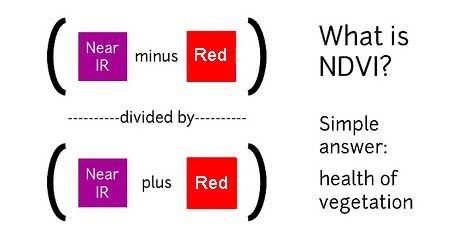](/i/44723) **NDVI = (Near Infrared - Red)/(Near Infrared + Red)** NDVI is a ratio which tries to emphasize photosynthesis while filtering out sun glare. The above equation is run for every pixel, using source data from an infrared photo and a visible light photo, like this pair: [](https://publiclab.org/system/images/photos/000/021/771/original/5390895115_c9d4d38fec_o.jpg) The result can be false-colored to make the high-photosynthesis areas more clear, and used to examine where plants are and how healthy they are. [](https://publiclab.org/system/images/photos/000/021/770/original/PetVISNDVIcomp.png) _Figure above: Normal color photo (right) and normalized difference vegetation index (NDVI) image (left). NDVI image was derived from two color channels in a single photo taken with a camera modified with a special infrared filter. Note that tree trunks, brown grass, and rocks have very low NDVI values because they are not photosynthetic. Healthy plants typically have NDVI values between 0.1 and 0.9. -- @cfastie_ ### Activities Here are a range of activities you can do to produce and interpret your own NDVI imagery, whether downloaded from a satellite imagery provider or [collected yourself using a DIY technique](/wiki/multispectral-imaging) [activities:ndvi] ****   Most DIY converted cameras today (those from Public Lab) use RGN instead of NRG, so the blue channel represents infrared instead of the red channel. That looks like this: [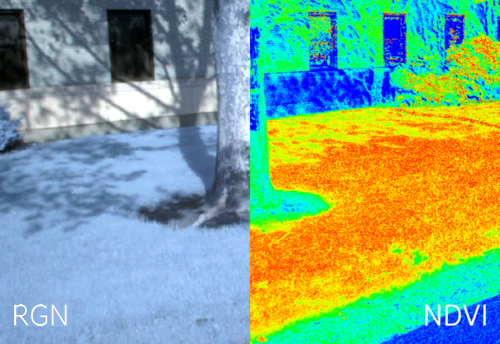](/i/45468?s=o) **** ## NRG imagery Some people are also interested in producing NRG imagery (like the below image), where `Near-Infrared, Red, and Green` are used to compose a picture instead of the usual `Red, Green, and Blue`. [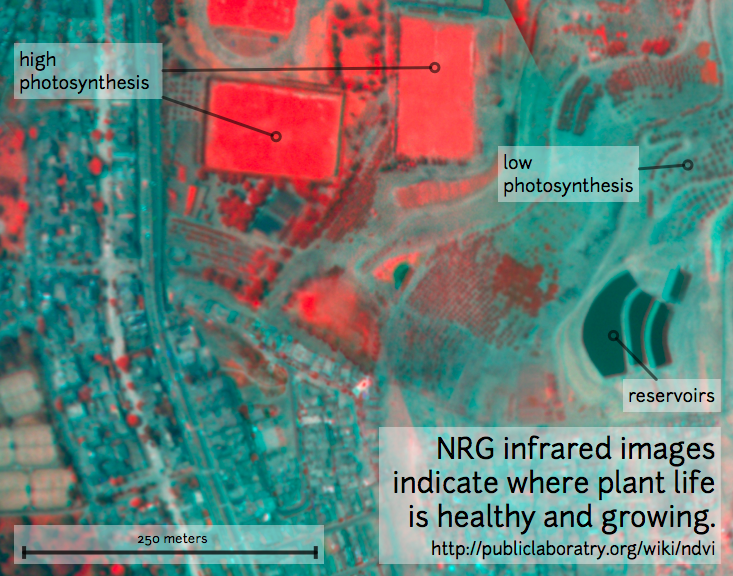](/i/25064) This diagram explains the swapping, which allows us to 'see' infrared as if it were a normal color: [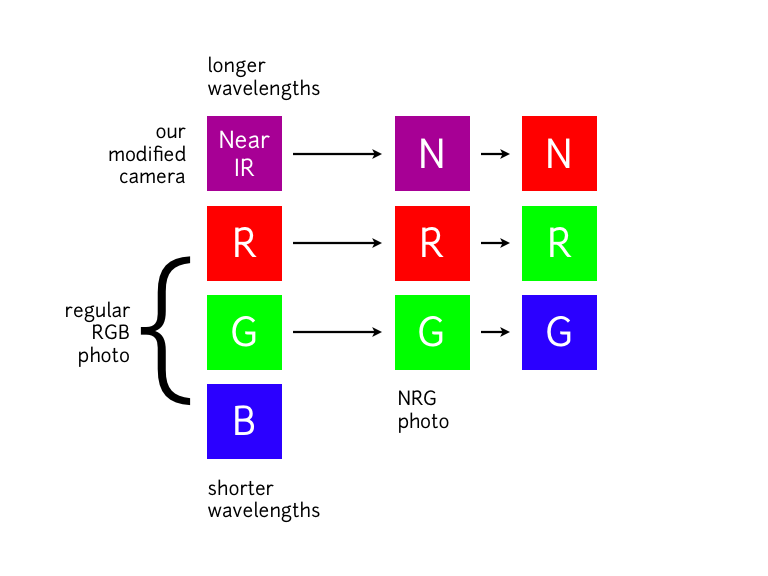](/i/25063) **In NRG images, the deeper and clearer the red color, the denser and healthier the vegetation (more or less).** ### Questions [questions:ndvi] ### Other examples of DIY NDVI imaging From around the internet: Begin watching at 2 minutes to see the resulting imagery: *This topic is part of the [Grassroots Mapping Curriculum](/wiki/mapping-curriculum) series.* **** [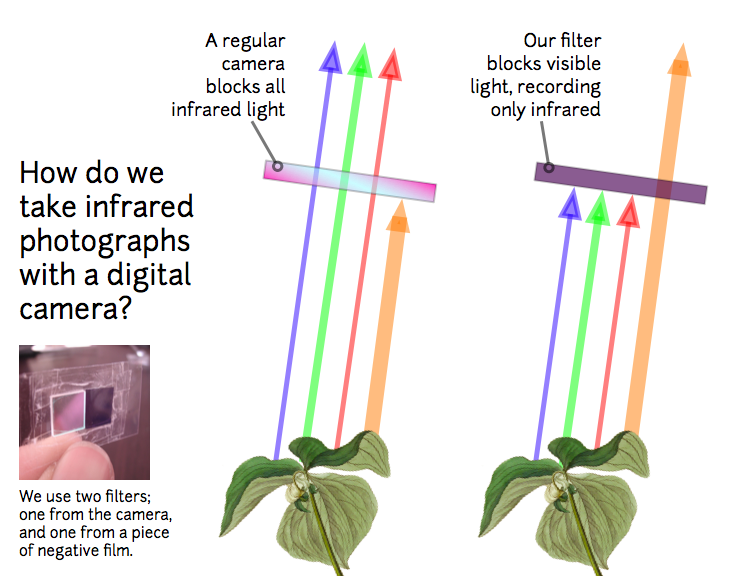](/i/25066) [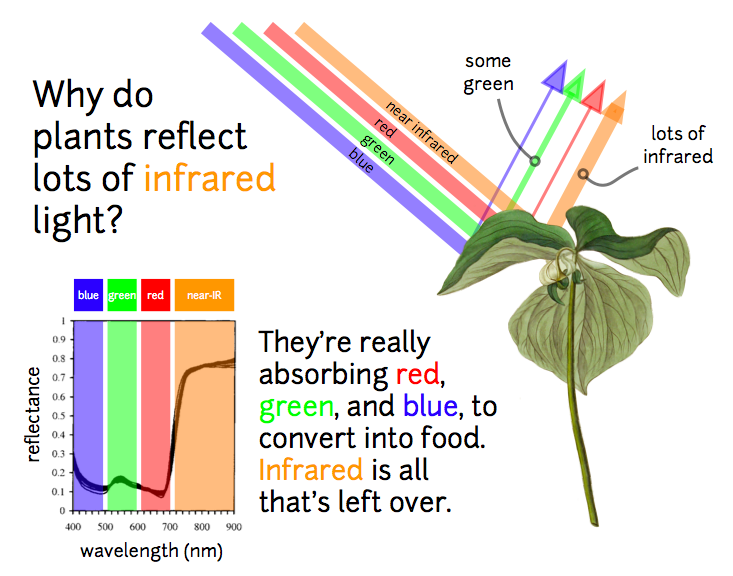](/i/25065) ...
| Author | Comment | Last activity | Moderation | ||
|---|---|---|---|---|---|
| jeffa_plain | "Yeah, I plan to use a point-and-shoot camera next (preferably one with optical zoom) so I can get proper NDVI imaging done. other than that, thank ..." | Read more » | over 2 years ago | |||
| warren | "Yes, i agree there is some infrared data showing in the trees, and I do think it's possible to get useful info out. Just be aware that the dynamic ..." | Read more » | over 2 years ago | |||
| jeffa_plain | "I did indeed remove the IR lens from this! Thats why I bought the GoPro 3+ Silver because that's the only GoPro 3 that has an easily removable lens..." | Read more » | over 2 years ago | |||
| warren | "I think if you got closer in white balance in pre-configuring the GoPros, you can probably un-boost the blue channel some more and get better disti..." | Read more » | over 2 years ago | |||
| jeffa_plain | "I was kinda hoping that this would be as simple as inverting the color scale at the bottom but nothing that simple with stuff like this haha. From ..." | Read more » | over 2 years ago | |||
| warren | "Hi, I think you're right that you need to adjust the white balance, and you can learn more about how that works here: https://publiclab.org/notes/w..." | Read more » | over 2 years ago | |||
| jeffa_plain | "I'm not sure where I would use the (1-R), I just tried it and I didn't get anything that was useable. all that needs to happen it seems is the resu..." | Read more » | over 2 years ago | |||
| jeffa_plain | "From the research ive done since making this post, I think it may be because I cannot adjust the white balance on a GoPro, both of the images are r..." | Read more » | over 2 years ago | |||
| warren | "Hmm, interesting, can you share your original images? I think we might just be able to do (1-R) instead of (R) or something, for some of the values. " | Read more » | over 2 years ago | |||
| brindamcolinasverde | "Also we need to understand that the pixels of your camera can be in different format. When you take a picture and put it in a webpage, like i menti..." | Read more » | about 3 years ago | |||
| iman | "Thanks @cfastie . The problem was with the Auto white balance and changing the awb from "auto" to "greyworld" solved the issue. " | Read more » | about 3 years ago | |||
| liz | "Thank you @cfastie! " | Read more » | about 3 years ago | |||
| cfastie | "I don't know what your camera's settings were and I don't know how your camera has been modified (does it have a red filter?). I don't know what th..." | Read more » | about 3 years ago | |||
| liz | "@cfastie , wondering if you might be around and able to drop some knowledge on this question? " | Read more » | about 3 years ago | |||
| sirromrobert42 | "I just want you to know that I am deeply grateful for your amazing post! Thanks for the kindness in sharing your expertise with us...Regards office..." | Read more » | about 3 years ago | |||
| juancitro | "Hi @velahs, The improvements you have obtained are really good. I would like to know, what is the process that you have followed to improve your ..." | Read more » | over 3 years ago | |||
| neenasharma4808 | "I visited your site and assumption I got some incredible information from your site, continue sharing such posts extensively further. Our http://ww..." | Read more » | over 3 years ago | |||
| EllenHarri | "Nice Post " | Read more » | over 3 years ago | |||
| MdSohanAli | "Good Article Thanks For Sharing " | Read more » | over 3 years ago | |||
| tumakin | ""Otherwise it would be a classic case of P-hacking." - I was thinking something along these lines as well. This is something I definitely wish to a..." | Read more » | over 3 years ago | |||
| shilpashetty | "I like your blog so much it is so Call Girls in Mumbai good it is very informative and good thank you. " | Read more » | over 3 years ago | |||
| cfastie | "Could you possibly point me to some literature regarding this? A lag between plant stress and NDVI response is commonly reported in the remote sen..." | Read more » | over 3 years ago | |||
| tumakin | "While messing about with the data, I came up with some other ways to approach the situation. Based on the pixel count of the "vegetative tissue" I ..." | Read more » | over 3 years ago | |||
| tumakin | "thank you for the reply @cfastie Your reasoning regarding the chlorophyll's performance under water stress sounds reasonable. "It seems that your..." | Read more » | over 3 years ago |